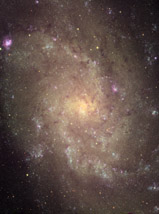|
OIR computing resources are mostly distributed on users'
desktops, some Linux, some Windows.
There are no longer any tape drives at the CF:
Consult the CF page:
http://www.cfa.harvard.edu/cf/ref/
Through OIR, the TDC makes available a computer for the
reduction of ground-based telescope data of all types. This
machine is named tdc2 and is a Dell PowerEdge 900
with 8 3 GHz cpus, 128 GB of memory, and a Gigabit
Ethernet connection.
The tdc2 computer is open for use by
anyone with a CF-domain account, and that has telescope
data to reduce. For more information, see the Web page:
http://tdc-www.harvard.edu/tdc_resources.shtml
Note that much of the data obtained at the MMT or Magellan is
reduced by the TDC staff. Contact tdchelp at cfa.harvard.edu for
details.
The CF runs the publicly-available computers neptune,
jupiter, cfa0, and mars.
Each has slightly different combinations of number of cpus, cpu
speeds and memory.
Note that neptune and jupiter are
located at CDP, so I/O from the
60 Garden St. complex is over a single shared Gigabit link.
See:
http://www.cfa.harvard.edu/cf/ref/System_Resources/public_computers.html
Much non-CF-supported software is available via the
tdc2 computer. For many of these programs,
it is necessary to include /data/oiropt/bin
and /data/oir/bin in your
PATH environment variable.
Note that the /data/oiropt directory is an
architecture-dependent mountpoint, such that a Linux system gets
Linux-appropriate binaries,
and a Solaris system gets SunOS-appropriate biaries.
- Catalog searching
- There are many catalogs
and software
search programs to make World Coordinate fits, finder
charts, etc.
- Starbase
- This is an RDB-type database manager created by
John Roll.
Include /data/oiropt/starbase near the beginning
of your PATH environment variable.
- The
Starbase documents give an overview of the
system.
- Funtools
- Fits Users Need Tools -
software to
ease the manipulation of FITS files in C
programming.
- CF-supported software
- The tdc2 computer is managed by the
Computation Facility with all their supported
software available.
- Still Other local documentation:
- See the
OIR local documentation web page.
There are several places to store data:
-
/data/oirperm /data/oirperm2
Two ``permanent'' storage spaces for any in OIR once
you're added to the group oirgroup. Files are
never deleted and are backed up nightly by the CF. You
make your own dir in /data/oirperm{,2} and away you
go. Please do not use this space for ordinary data
reduction.
-
P.I. disks (various)
There are PI disks, also permanent and usually
backed up. If you don't already know of such a disk,
the owner probably doesn't want you to use it.
-
Scratch disks
Scratch disks are
intended for data reduction, not permanent storage.
Scratch disks are not backed up, and are purged after
90 days.
- /pool/tdc3
/pool/tdc5
/pool/megascr1
- These are NetApp NAS filers
available via NFS. They are intended for use by CFA
staff & students for ground-based telescope data
reduction.
Anyone can make directories on /pool/tdc5 (i.e. no
group restrictions); /pool/tdc3 is limited to members of
group oirgroup, and /pool/megascr1 is
restricted to
members of megagrp.
In addition, /pool/tdc5 is
each week of files older than 155 days, /pool/tdc3 is purged
each week of files older than 90 days, and /pool/megascr1
is never purged.
Finally, these disks are not backed up, but
are protected by parity and hot-spare
disks in the RAID arrays, including limited snapshotting
of up to about a week.
| 



